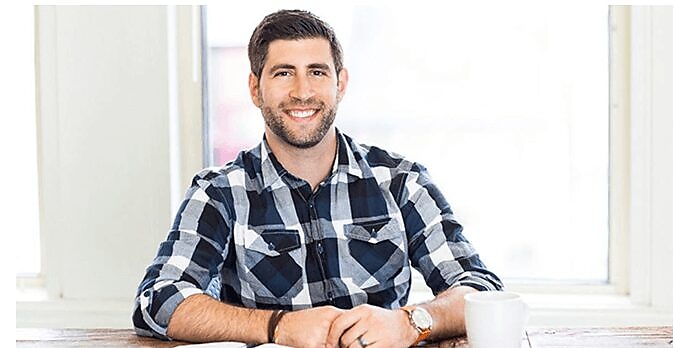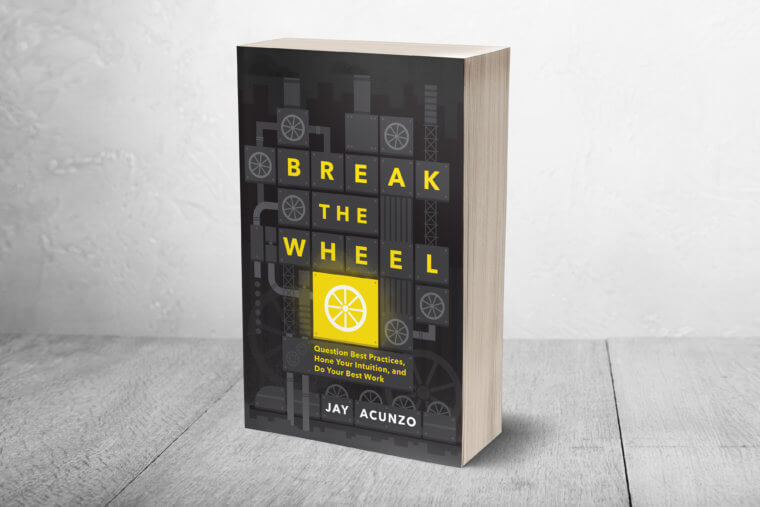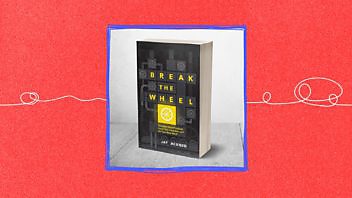
Jay Acunzo is a rare beast.
In a world full of marketers addicted to quick wins, no-brainer hacks and next-big-things, he’s the oddball who pauses to consider what’s really going on here. To advocate for the slow game.
Against an endless parade of ego-pumped pseudo-gurus peddling magical formulas, he’s the guy with the awkward questions, compelling stories and sit-up-and-say-“Shit!” insights.
Jay has left behind more great jobs than most of us will ever fantasize about—at places like Google, Hubspot and NextView ventures. Those experiences compelled him to start an entirely new kind of media company called Unthinkable Media, where he makes cool, fun, smart and entertaining shows about business. He also speaks at conferences, writes, podcasts, feeds the dog, tries to hold up his end of a marriage, prepares for a daughter [This just in: she’s here!] and juggles the kind of side projects most of us call ‘careers’.
And now the bastard has gone and written a book. A really, really good book.
It’s called “Break The Wheel: Question Best Practices, Hone Your Intuition and Do Your Best Work” (Oxford comma omitted to protect all that is holy). It looks like this:

.
I read a LOT of marketing and business books. And for every one I actually read, I skim another ten. Most are okay. A few suck. And one in, say, a hundred is really worth tearing yourself away from social media for.
Break The Wheel is that exception: true, inspiring, full of great stories and a surprisingly effective approach to harnessing intuition for your business. It’s also funny and really well-written, so you’ll enjoy the journey.
I’m not just saying this because he says nice things about me in it (on pages 149-150 and again on page 158 — I turned down the corners, highlighted the passages and leave print-outs lying around to be discovered by people whose appreciation for the glory that is me appears to be waning).
I want you to buy this book, read it and let me know what you think, in a comment below (and, what the hell, as long as I’m giving out assignments, a review on Amazon).
When I finished it, I clapped on the bus, then shot him an email asking for an interview for this blog. He said, “Fuck off, Kessler, I’m busy.” But I persisted, sending email after email in the style of today’s automated Business Development Reps (“You may have missed my last 12 emails…” etc).
Eventually—whether from exhaustion, pity or backlink-greed—he relented. Here’s the annoyingly articulate result:
You’re inventing a new kind of media company and bootstrapping it with yourself as the first product. Can you describe this new thing? What the hell are you up to?
Unthinkable Media develops original series for B2B brands specifically. This was born out of a personal frustration with B2B content and a market shift we aren’t discussing overtly enough.
The personal frustration is that, while we experience a lot of emotion and meaning in our work, B2B content rarely reflects that. Instead, most of it is hollow or redundant, while even the good stuff is merely “smart.”
First of all, we don’t want commodity careers or companies, and second, the “smart” stuff can feel like sticking a textbook down someone’s throat. Unthinkable Media creates what I’d call nutritious and delicious shows instead.
That’s my personal bent on this. The market shift is where CMOs and I spend the most time in conversation however. It used to be the case that marketers were in the business of acquiring attention. You’d get a few seconds here and there, spread across a few different mediums and channels. But if you look today’s reality in the eye (yanno, that thing we should be focused on instead of all those damn 2019 prediction articles), you’d see what’s been happening for over a decade now: The buyer has all the power, because the buyer has infinite choice. In that world, brands can’t simply acquire attention. The new marketing mandate is to hold it.
Well, it turns out there’s a great vehicle for doing exactly that: make a show. Shows not only capture tons of time, they turn passive audience into an active community, help brands own a theme outright in the market, and provide efficiencies across channels for marketing teams, as endless content cascades from or gets inspired by the series.
When people talk about intuition in business, they usually think about ‘big picture’ visionaries who see major trends more clearly than others. In ‘Breaking the Wheel’, you go the other way, urging people to drill down into their own specific situations, in granular detail. How can the Road to Exceptional go through this seemingly prosaic stuff?
Intuition gets a bad rap in the business world because it’s been so misinterpreted over the years. As a result, people have extreme reactions to it. You either laud the idea because you’re a creative type (as I do/am), or you reject it as too fluffy. But set aside the idea for just a moment, and consider the following statement:
Finding best practices isn’t the goal. Finding the best approach for you is.
Everybody in the working world would agree, and almost nobody knows how to do that. This is insane! We have endless approaches and even dedicated time for finding best practices, and yet we don’t have a plan in place when we make decisions. This is a huge issue today. Best practices aren’t final answers. They’re possibilities. The true skill in our work, then, is the ability to vet all these possibilities. How can we make someone else’s or even our own ideas work well for us? We have to add in what best practices miss. We have to add in the “us” part. The details of our own context hold vital clues we can use to make better, more informed decisions and thus tailor our work to fit our situations. Intuition just happens to be the name of that skill.
In the book, we go on a brief journey together through history to understand how the scientific research and popular understanding of intuition has changed over time. We visit the work of two researchers in particular, Gary Klein from the US and Gerd Gigerenzer from Germany, who show us how intuition is our ability to sort through the variables of our environment and more easily arrive at a good conclusion. Their research aligns with the very word itself, as “intuition” arose from the Latin intueri, which means simply “to consider.”
The point isn’t to debate if intuition is valuable or not. The point is to improve your ability to consider your context first, then decide if a trend or precedent will work for you, and to what degree. Bonus points if you can make those choices quickly. In the book, we explore the right questions to ask to begin making these decisions, i.e., honing your intuition. This isn’t about the mythical muse. This is about making better, more strategic decisions in a practical way: by informing them with the variables found in your specific context.
You make it sound like anyone can learn to tap into their intuition. But isn’t it a talent too? Aren’t some people (like you) just way better at it than others? Should they leave it to those folks or just keep banging their heads against the wall?
Yes, some people are better at “it” if by “it” we mean what intuition really is: making decisions that are tailored to our real-world situation. However, I’d caution against our typical knee-jerk reaction in business, which is to conclude that some people are “visionaries.” In reality, visionaries don’t see the future. They just see the present more clearly than most.
In my research, I uncovered a psychological phenomenon called “cultural fluency,” which is our behavior when the world unfolds as we expect. In other words, when things feel comfortable, or familiar, or routine, we go with the flow. We’re mindless.
All those people who hone their intuition, however, snap out of it. They’re mindful, considering their environment more clearly to make better decisions. Whether or not you have “talent,” THAT is a skill you can learn. The opposite of cultural disfluency, or moments where something feels a little off or different or uncomfortable. Asking open-ended questions (six of which I propose in the book) does the trick, as you admit you don’t have “the” answer or best practice, and must then go think more critically to solve a problem.
Can you have a “talent” for asking good, open-ended questions? Maybe. But I’d argue that’s something we can all do and get better at doing at that.
Your six questions are paired up: one Trigger question and one Confirmation question per area. Why is this important? How does it help?
These are the two types of questions we can use, and I propose six in the book — two apiece that we can ask of the three different variables present in every decision at work.
Trigger questions are open-ended questions about your environment. They spark your investigation and can only be answered through reflection and testing. Confirmation questions then ensure you have sufficient signal that you’re on the right path, even if that path is new.
Imagine a jungle blocking your path to a mountain peak you see in the distance. That peak is your best work, and the jungle contains all kinds of paths you might take to reach it. Everyone around you might be urging you to turn right, but you believe you should go left. Should you listen to the experts or your own gut? The only way to tell is start hacking through the brush, but you shouldn’t merely pick a path and cling to it on principle. You should take a swing, then see where that got you. That’s the trigger question and confirmation question working in tandem. What do you know, and where does that get you? Investigate that new path, but ensure it’s indeed the right path for you.
Don’t just hack away. Take a swing to clear some brush. Then evaluate where you’re at.
Don’t just pick a path because it’s a trend or a past precedent or your own idea. Investigate. Confirm. Proceed.
Is your methodology not a form of ‘best practice’?
I consider best practices to be possibilities, so in this way, yes I’m proposing some possibilities in the book. However, I think there’s a crucial difference. You won’t find any blueprints or prescriptions, only questions that we can each ask back in our work.
If you and I are direct competitors and ask these questions, we’ll both land in fundamentally different places. Some books are directions drawn on the map, some are maps, and some are compasses. This book is a compass, with the six questions being my suggestion for how the map might look.
I want to you to use those six questions to create a sort of “instant clarity generator,” such that you can press the information you have through it and know exactly what you should do next. As for what those inputs are, and what the path forward becomes? That’s up to you. And I encourage people to come up with their own questions. It doesn’t matter if you use mine. It matters you make the best choices FOR YOU.
Your book feels especially powerful for entrepreneurs — for people who have power over their own destinies. But what about people in big companies, with their pesky stakeholders? How can your readers get their whole team — and the execs they report to — to adopt an ‘investigator’ mindset instead of an ‘expert’ one?
Part of this has to do with how we communicate our ideas. We tend to do so backwards. I call this the Green Smoothie Problem. Suffice it to say we have our focus all out of whack. We shouldn’t sell our ideas. We should sell why our ideas should exist.
In doing so, we avoid a major problem others face when we try to help our bosses, clients, or teams to see the world as we see it: We create an information disadvantage. We know the idea or answer, and we leap right to it. They don’t, and because we’re lousy at discussing our ideas, we leave it to them to fill in the gaps. They come up with the reasoning as to why our ideas should or shouldn’t exist — whether that’s “buy Jay’s book,” “act like an investigator,” or “hire a monkey to walk around the office every Friday and hand out cocktails.”
Don’t get me wrong, I’M instantly on board when you scream, “Tequila Monkey!” But others may not quite get how you arrived there, and THAT is your opportunity to be more convincing.
In reading the book, I was thinking about how I’d answer the six questions for Velocity, of course. But I was also thinking about your business, Unthinkable Media. I’d love to know how you answer your own six questions. But maybe we can just look at two:
One is a Confirmation question: What’s your unfair advantage?
My unfair advantage is the ability to find emotion and meaning in the seemingly mundane details of people’s work lives when I tell their stories.
From fun and funny to sappy and saccharine to everything in between, I’m willing to venture into some of the bigger questions and more emotional, human sides of the business world that most won’t touch or don’t believe are present. I’m not sure why, either. Maybe there’s a fear of being too vulnerable, or that they won’t be taken seriously anymore, or simply because emotions and human stories aren’t typically associated with the business world beyond the whitewashed success stories of business lore.
I can’t say for sure why I’m so comfortable and adept at these stories. Whether through my background in sports media, my career as a writer and speaker, my 35+ side projects launched since 2008 (yep, I counted, I have an addiction), or my own tendency to get romantic about the big stuff, I tend to feel most at home when telling emotionally charged stories about B2B topics.
The next is a Trigger question, about your available resources: What are your constraints?
As I discuss in the book, researchers continue to show that constraints yield better creative thinking. I have four big self-imposed constraints, but there are dozens of circumstantial limitations like time, budget, technologies, and more.
My four self-imposed constraints when making shows help me vet who I will and won’t work with. I work with (1) growth-stage B2B startups or challenger B2B brands who (2) have had some success already in building an audience with content marketing and (3) require creative direction and/or on-air talent, not merely last-mile production, and (4) want to create a refreshingly enjoyable, original series, not simply Yet Another Expert Interview Show.
Why write a book? Isn’t that kind of old-school for a guy who’s inventing a new kind of media company in digital times?
I wrote a book for the same reason I do all my work: I wanted it to exist. And, oh by the way, when you do something that you’re intrinsically motivated to do, instead of “to generate results,” so often you get better results.
There are tangential benefits to be sure. I really want to help people because commodity work is a real problem that frustrates many more people than just me. My keynote speaking business gets a boost on the book of my book. But really, I felt I’d found the Venn diagram overlap between what I wanted to write and what others wanted to read, and for that reason, I just wanted this thing to exist.
Is there a risk that publishing a book forces you to change the theme of your next 12-18 months from, “Do great things” to, “Buy my book”? Asking for a friend.
Well, if that doesn’t make you want to read the book, you’re just not the target audience.
And, if we had you at Acunzo, here are some things to do about it:
Check out his blog about marketing and business.
Subscribe to the Unthinkable podcast about counter-intuitive but super-effective strategies.
Try his whiskey: Acunzo’s Fire, and buy your niece the Achieving Average board game (ages 6+). Um. Kidding.
Thanks, Jay! Good luck with the new kid—and with12-18 months of people sneaking up behind you, yelling, “Tequila Monkey!”.
—
Jay photo by Monumental Shift.
Book photo prolly by Jay.

Enjoyed this article?
Take part in the discussion








Comments
There are no comments yet for this post. Why not be the first?